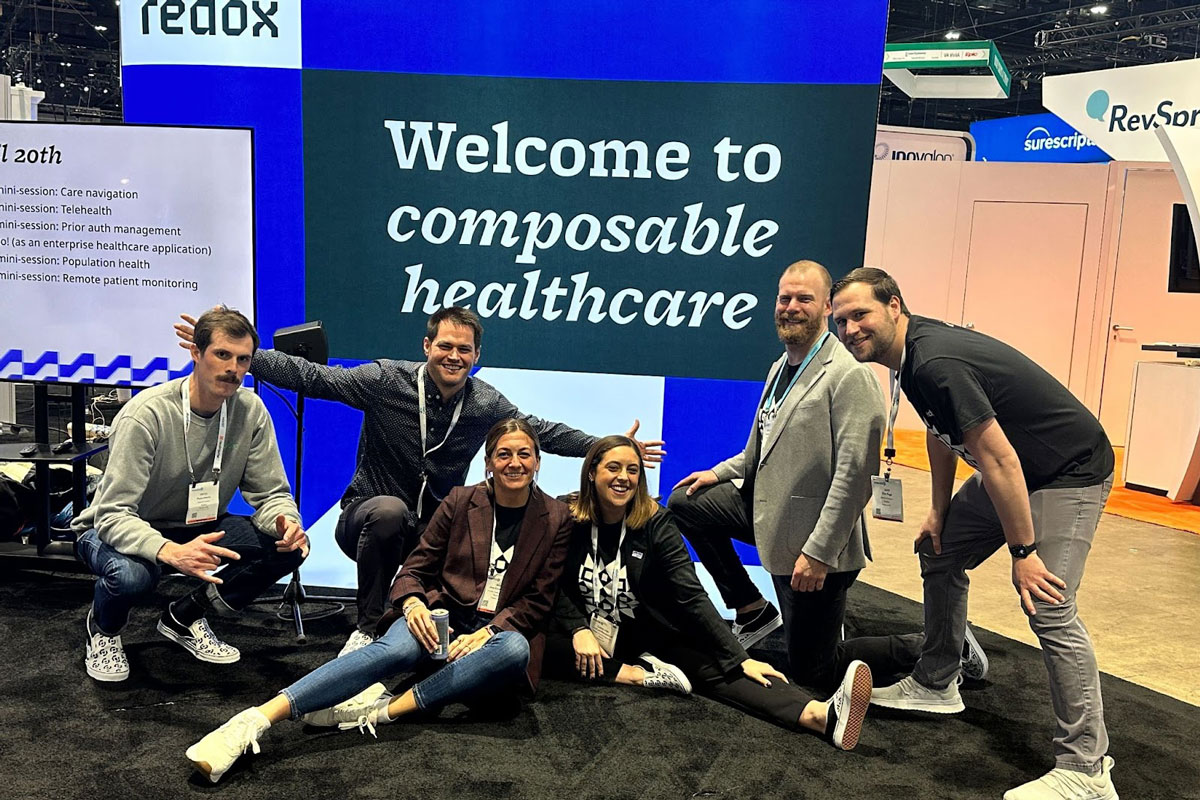Post-pandemic HIMSS v1.0 - 2023’s event unwrapped
Apr 28, 2023

Last week was the biggest event/spectacle in health IT, the “World’s Fair of Healthcare”, also known as HIMSS. Many of the Redox team joined the 35k+ attendees and set up shop amid 1k other companies on the exhibition floor at McCormick Place in Chicago.
I am a HIMSS newbie, so the size and scope seemed huge, even overwhelming at times, but veterans noted a noticeable temperance to this year’s event. There were fewer over the top giveaways, and less pomp and circumstance in the booths. While I have no means of comparison, I appreciated the practical approach that most companies took - focusing on building genuine awareness through thoughtful solutions-focused conversations and content.
Beyond the exhibition floor, HIMSS assembled a truly dizzying agenda of presentations and panels for attendees. While there were not overt themes (or if there were, I missed them), a few certainly emerged - the application of AI in healthcare, health equity, the future of healthcare (in a post-COVID world), and our personal favorite, interoperability.
Artificial intelligence
AI made for the buzziest headlines leading up to HIMSS, so it is no surprise that it was also the buzziest topic at HIMSS itself. The opening keynote was focused on the responsible use of AI in healthcare, and by my count there were more than a dozen other sessions on the agenda that broached AI-related topics. A number of companies also made AI announcements at/around HIMSS including the integration of GPT3 in Epic and eClinicalWorks, and the use of AWS AI technology by 3M and Philips. While few booths were “over the top” this year, AI-focused products certainly stood out on the exhibition floor. The Nuance booth in particular had a massive footprint, and could not be missed. It is clear that AI is making rapid inroads in an industry known for resistance and slow adoption. While there are a number of security and ethics questions that certainly need to be answered, I am here for it.
Health equity
Health equity also played prominently on the HIMSS agenda, with 13 sessions on the topic. I feel optimistic that it still has real momentum as we get further and further removed from the spotlight that the pandemic placed on it. Sessions on how AI, data standards, and interoperability will help propel us to a more equitable landscape filled me with enthusiasm for what comes next. This said, I do think HIMSS can take more care in ensuring diverse representation of panelists/presenters on health equity (and also in general). Like our friend Shereese Maynard, I was disappointed to see an all white panel for the keynote on health equity.
The future of healthcare
If the restrained exhibition hall wasn’t enough evidence, session titles like “In This Economy? Investing In Digital Operations To Reduce Costs” , “Existential Crisis or Inflection Point Opportunity? An Industry Maverick’s Perspective”, and “The Post-COVID Health System – Challenges and Opportunities” made it clear that there are many questions about what the future of healthcare looks like in our current post-COVID economy. While it felt a bit ominous to see it front and center, there were points of light. It is clear that the future of healthcare will involve (demand) increased collaboration and partnership across the landscape. Wednesday’s keynote from Best Buy, VillageMD, and HealthPartners executives showcased the collaborative opportunities that will continue to disrupt how healthcare is delivered, and move us well beyond “traditional” settings.
While HIMSS touts a robust agenda and expansive exhibition, some of the greatest value is providing a venue to bring current and future partners together. It is reasonable to question if events like HIMSS are really necessary or even prudent in today’s environment, but if collaboration and partnership are what will move the industry forward, then HIMSS can be a key enabler. For Redox, many of the most pivotal conversations we had at HIMSS were with our partners. The energy coming from these collaborations can not be understated.
Interoperability
Interoperability has played prominently at HIMSS for well over a decade now, and will likely continue until the problem is solved. Challenges around enabling secure, compliant data flow and exchange between legacy systems continue to plague healthcare. Sessions like “Interoperability. What’s Taking So Long?” tried to help attendees understand both what progress has been made, and why it continues to be so complicated. And sessions like “A Playbook for Connected for Health: An Overlooked Strategic Imperative” presented the ongoing challenges providers face in managing data exchange through legacy channels like fax and legacy data standards like CCD. While it does seem unimaginable that we have been talking about this for a decade, recent movement on the TEFCA front, continuing FHIR standard adoption, and a renewed regulatory push from CMS provide a fair amount of optimism for the future.
We loved being a part of the interoperability conversation at HIMSS and were excited to share a number of our solutions in our booth. We showcased all of our newest products, talked about how key partnerships with organizations like Verato and Databricks are propelling them, and how Redox’s in-depth FHIR and workflow-specific integration expertise can be game changers.
Beyond interoperability, we also appreciated being part of a broader conversation about how to make healthcare a better, more equitable place to build a career - our CEO Luke Bonney, and Chief People Officer, Chloe Drew, joined Shereese Maynard to discuss the role men play as allies in advancing gender equity in healthcare leadership. Check out the transcript is available on the HIT Like a Girl Pod website.

Overall, HIMSS was a “win” for me and for Redox this year. I look forward to seeing how the event evolves in the coming years as we firmly settle into the post-pandemic era.
